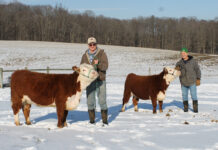Spring is an exciting time to observe wildlife – baby birds in nests; fox, squirrel, rabbit, chipmunk, skunk and raccoon kits nestled in dens; opossum joeys catching a ride on mom’s back; deer fawns bedded down; bat pups hidden in hollow trees and vacant buildings; tadpoles swimming in creeks, ponds, streams and vernal pools. The new life around us never feels more abundant than springtime.
But, it’s important that you resist the urge to help and stick to observing young wildlife. These babies receive the best care from their parents. Not only is it difficult to care for young wildlife, but there are also a number of other potential problems. Wildlife can carry disease, putting your pets and family at risk. They can also get used to human interaction and being cared for, which can result in a diminished instinct to fear humans. In this scenario, the rescued wildlife would have a difficult time adjusting to the wild again when it’s ready to be released.
Although it’s not wise to try to care for young wildlife in the spring, there are plenty of other things you can do to help wildlife in the spring and year-round.
4 ways to help wildlife
Plant natives. By planting gardens filled with native flowers or landscaping your yard with native trees and shrubs instead of the “prettiest” plants, you’re creating sources of food and shelter for wildlife. Native plants are the ones that naturally occur in your area, plants native wildlife depend on for food and shelter. Non-natives don’t have these benefits because they are not part of the same ecosystem, typically.
Another benefit of planting native plants is that they are low maintenance. They don’t require as much water, fertilizer or attention because they are naturally adapted to the climate and growing conditions where you live.
Lastly, don’t be fooled into thinking planting native varieties means your gardens will be dull and boring. Plenty of native varieties offer color and beauty. Purple coneflower, butterfly weed, black-eyed Susans, Ox-eye sunflower and milkweed are a few showy plants to consider.
Leave brush piles. Brush piles provide cover for wildlife that can be used as shelter, a place to store food or even a spot to hide from predators. To build a brush pile for wildlife, pile up logs, branches and cuttings, leaving gaps for wildlife to enter and exit. Future inhabitants may include northern cardinals, rabbits, chipmunks and a myriad of insects (that could end up as a food source for those higher up the food chain).
If you’re considering a brush pile, but not sure it will be ascetically pleasing, you may consider planting native vines at its base to grow over it.
Leave snags standing. You can help wildlife by leaving dead or dying trees (snags) standing. As a tree decays, insects and birds bore out holes, eventually creating larger cavities that birds and mammals can use to nest. Bats, in particular, like to use snags to raise their pups, nesting in the narrow spaces between the bark and wood of the tree. Additionally, the presence of insects and insect colonies in the wood provides a food source for birds and tree frogs.
Nestboxes and bat houses. Providing places for wildlife to raise their young is important, especially in more urban areas where native plants, brush piles and snags are few and far between. One way to do this is by putting up nestboxes and bat houses.
The most important things to consider when building nest boxes and bat houses are construction materials, proper drainage, ventilation, predator exclusion and the size of the entrance hole. You can find tips for designing, building and placing nestboxes and bat houses by visiting the Ohio Department of Natural Resources Division of Wildlife at wildohio.gov or by checking out the links below.













